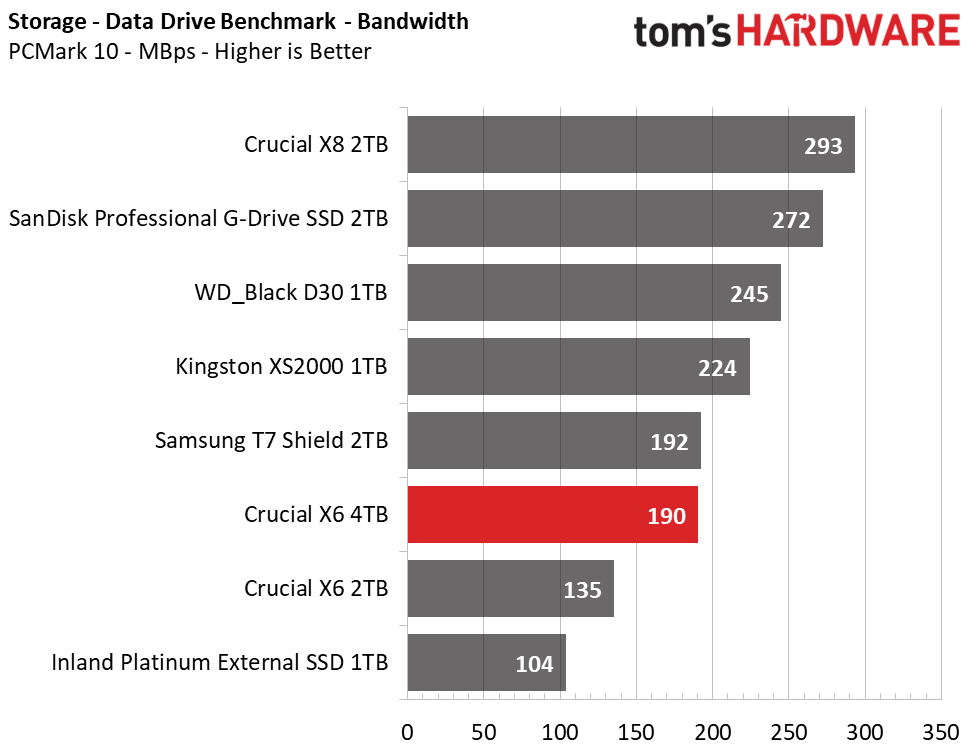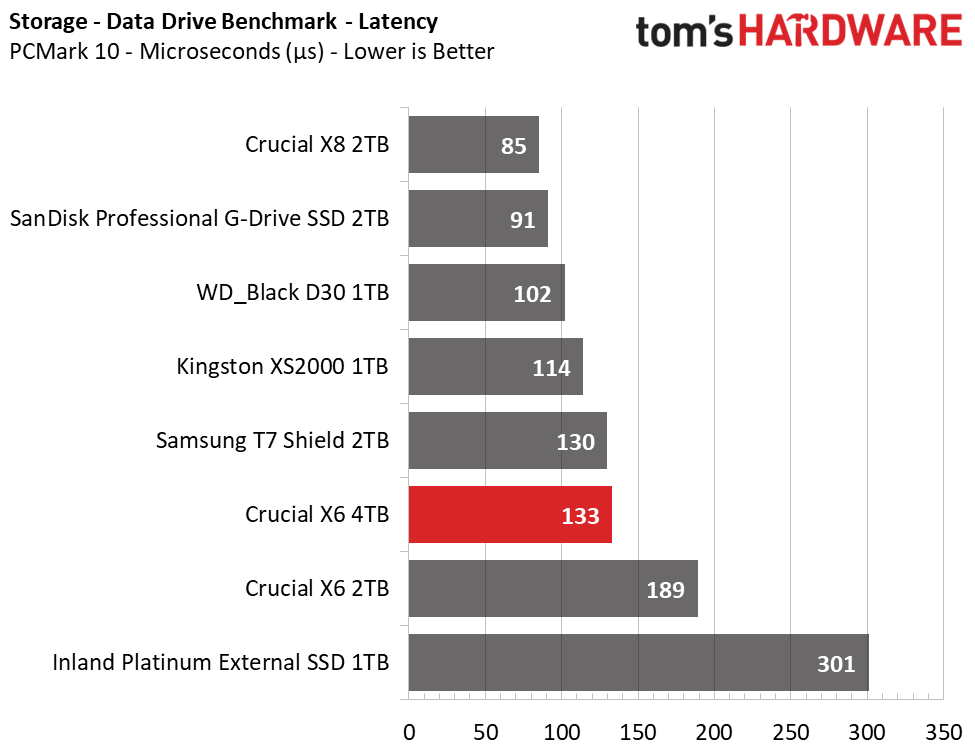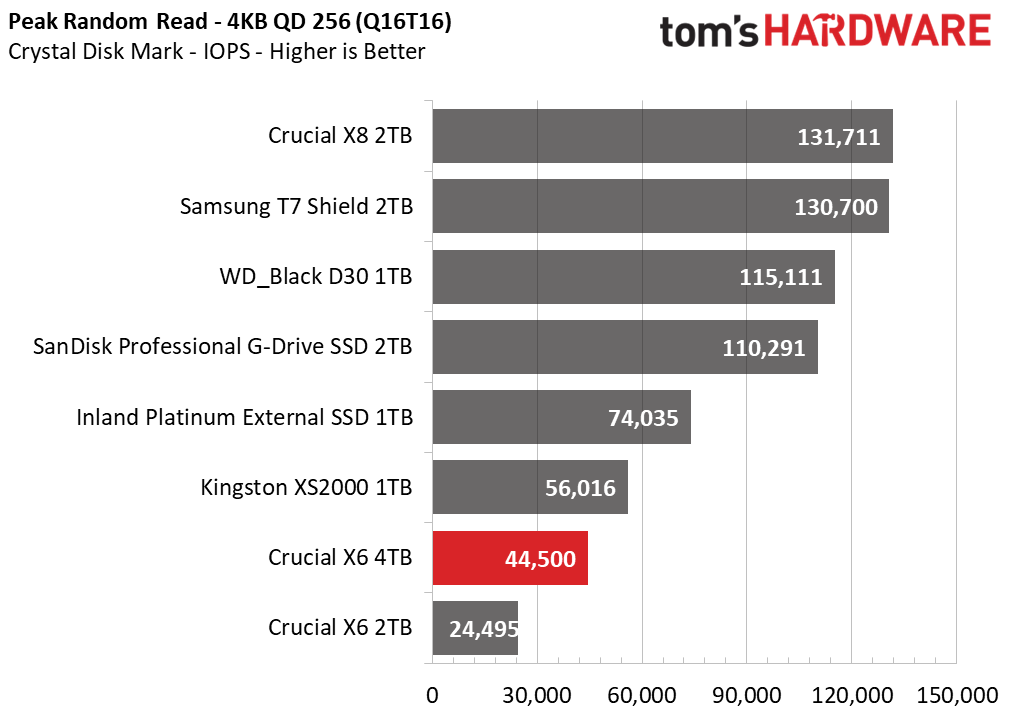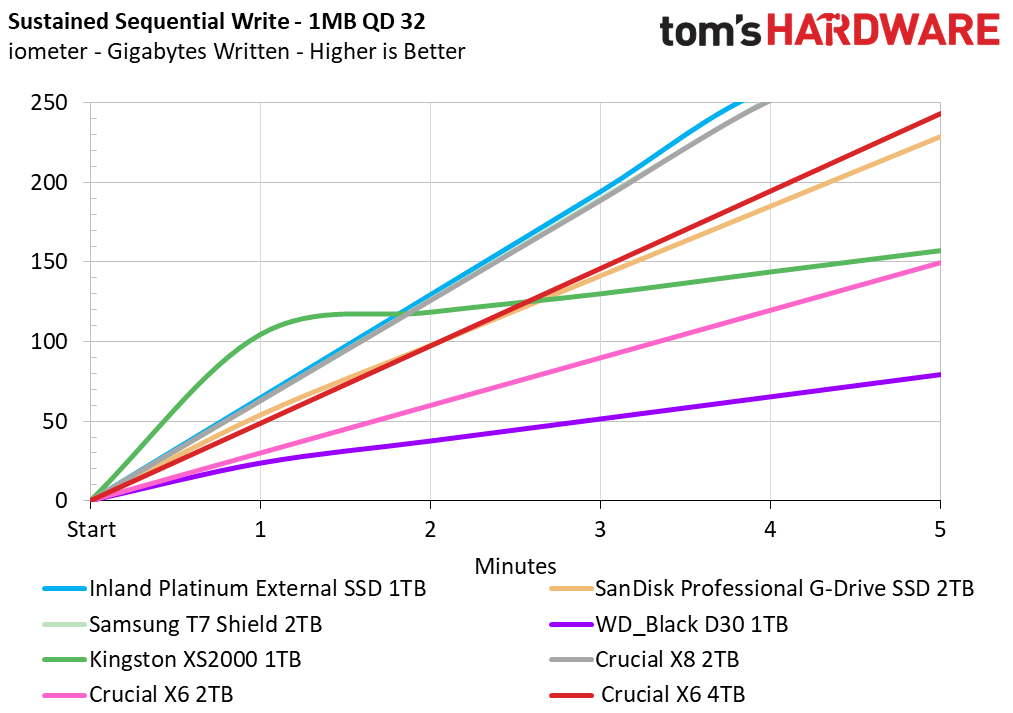Why you can trust Tom's Hardware
Comparison Products
We put the 4TB Crucial X6 against a variety of other portable SSDs, including Crucial’s own X8 and the original X6, both at 2TB. We also included the 2TB Samsung T7 Shield and SanDisk’s Professional G-Drive. The remaining three drives — Kingston’s XS2000, WD’s Black D30, and the Inland Platinum Internal — are 1TB.
These drives use different controllers and approaches to bridge chips. For example, the XS2000 has a hybrid design, so we can see differences in approach. The choice in flash also varies, so we’ll see how much of an impact QLC flash has on performance.
Game Scene Loading - Final Fantasy XIV
Final Fantasy XIV Shadowbringers is a free real-world game benchmark that easily and accurately compares game load times without the inaccuracy of using a stopwatch.
Having 4TB of portable storage could be nice to haul around your games. Unfortunately, the new X6 doesn't do very well in this test. Most likely, it’s still close enough to other SSDs in game loading times that it will be just fine for this type of usage. It’s not a surprise it comes close to the Platinum External as the drives have similar hardware - the U17 controller with QLC flash. The older X6, which had a separate SATA controller and bridge chip paired with QLC flash, is significantly faster.
Other drives with normal controllers also fare well and perform relatively close to each other. The Kingston XS2000, which uses SMI’s UFD design, is a big surprise. However, that drive uses TLC rather than QLC like the new X6.
Trace Testing – PCMark 10 Storage Benchmark
PCMark 10 is a trace-based benchmark that uses a wide-ranging set of real-world traces from popular applications and everyday tasks to measure the performance of storage devices.



The new X6 does better here, beating the old X6 and the Platinum External. The uplift over those two drives may come from Micron’s newer 176-layer QLC. We haven't seen this flash used much yet, but expectations are that it will match or exceed Intel’s 144-layer QLC. That QLC is used in Intel’s 670p, while most other QLC drives on the market use 96-layer QLC from the time of Intel and Micron’s cooperative efforts. For you, this means more consistent performance with the new X6, all else being equal. The extra dies in the 4TB X6, as opposed to the 1TB Platinum External, can also help sustain bandwidth.
Get Tom's Hardware's best news and in-depth reviews, straight to your inbox.
We nevertheless see better performance from the rest of the drives, although these have TLC or, as in the X8’s case, a faster controller and interface.
Transfer Rates – DiskBench
We use the DiskBench storage benchmarking tool to test file transfer performance with a custom, 50GB dataset. We copy 31,227 files of various types, such as pictures, PDFs, and videos to a new folder and then follow-up with a reading test of a newly-written 6.5GB zip file.



The new X6 also does better in DiskBench, where its faster interface propels it above the old model. It also beats the WD_Black D30, likely thanks to its large SLC cache. It’s unable to keep up with drives with faster interfaces and higher maximum bandwidth, though. This drive is clearly more about capacity and portability than raw performance.
Synthetic Testing - CrystalDiskMark
CrystalDiskMark (CDM) is a free and easy-to-use storage benchmarking tool that SSD vendors commonly use to assign performance specifications to their products. It gives us insight into how each device handles different file sizes.










In CrystalDiskMark’s sequential tests, the new X6 again does better than the old X6. It has a faster interface than the original design, so that’s not surprising. However, it does remain a bit behind most of the other 10Gbps options, which, while matching Crucial’s 800 MBps specification, has it fall below what the U17 can do, as demonstrated in our Platinum External review.
Performance in random workloads is a bit better, thanks to the use of a hybrid controller. Of course, you will still be constrained by the USB interface and, in some cases, the QLC flash, but these are reasonably good results.
Sustained Write Performance, Cache Recovery, and Temperature
Official write specifications are only part of the performance picture. Most SSDs implement a write cache, which is a fast area of (usually) pseudo-SLC programmed flash that absorbs incoming data. Sustained write speeds can suffer tremendously once the workload spills outside of the cache and into the "native" TLC or QLC flash. We use Iometer to hammer the SSD with sequential writes for 15 minutes to measure both the size of the write cache and performance after the cache is saturated. We also monitor cache recovery via multiple idle rounds.





The 4TB X6 writes in SLC at a bit more than 800 MBps until its SLC cache is full. As with the 1TB Inland Platinum External, all of the QLC flash can run in this single-bit mode. For a 4TB drive, this comes out to around 1TB — a massive amount. After the drive exhausts the cache, it is forced to copy back incoming data to QLC at a bit below 60 MBps. You don’t want to run out of cache on this drive.
The massive cache allows the drive to out-write the old X6, and, if given enough runway, it does well against every other drive in the list except the T7 Shield. This is not surprising as the T7 Shield was designed for consistent write performance, with fast TLC and a relatively small SLC cache. The X6 is more reasonable for the type of use such a capacious drive would see: bursty file transfers, with more reads than writes. The X6 would work nicely as a backup or archival drive, although SSDs should be plugged in and read at least once a year to ensure data retention.
As with the Platinum External, the X6's cache recovery was relatively quick. This type of design makes sense because the drive is trying to hide its poor QLC performance and needs to free up its “real” capacity as quickly as possible. This could cause issues in some edge cases, particularly with a fuller drive, although this is not a new caveat for DRAM-less QLC SSDs.
The X6 runs relatively cool, idling at 30C as measured by the temperature gun and 40C via SMART. The drive saw no throttling even after writing 1.2TB of data with a surface temperature of 39C and a SMART reading of 53C. Portable drives may have to face hotter environments outdoors, and you also need to be able to handle the drive’s case — therefore, the low drive and surface temperatures are in the X6’s favor.
Test Bench and Testing Notes
| CPU | Intel Core i9-11900K |
| Motherboard | ASRock Z590 Taichi |
| Memory | 2x8GB Kingston HyperX Predator DDR4 5333 |
| Graphics | Intel UHD Graphics 750 |
| CPU Cooling | Alphacool Eissturm Hurricane Copper 45 3x140mm |
| Case | Streacom BC1 Open Benchtable |
| Power Supply | Corsair SF750 Platinum |
| OS Storage | WD_Black SN850 2TB |
| Operating System | Windows 10 Pro 64-bit 20H2 |
We use a Rocket Lake platform with most background applications such as indexing, windows updates, and anti-virus disabled in the OS to reduce run-to-run variability. Each SSD is prefilled to 50% capacity and tested as a secondary device. Unless noted, we use active cooling for all SSDs.
Conclusion
The new Crucial X6 offers greater speed and larger capacities in an extremely portable form factor. The drive is diminutive and basic but designed to survive a two-meter drop. We had no issues with overheating. The drive is also priced right if you need this much capacity. It would work well as an external archival or backup drive and is easy enough to carry around in a pocket to be useful on the go. However, it’s designed to be cheap, which has some significant drawbacks.
The drive’s performance in sequential workloads is lackluster, trailing other 10 Gbps USB drives, including ones like the Inland Platinum External with similar hardware. Drives with a 20 Gbps interface and/or TLC are simply faster and more consistent. Random performance is better than one would expect, thanks to the hybrid controller, which should also be more efficient. However, on the whole, this is not a very performant option and power draw is often a secondary concern.
The X6 only comes with a three-year warranty and lacks a Type-C to Type-A cable out of the box, both of which could be limiting. The optional cable adds to the potential overall cost. Still, the X6 is a better option than an HDD and it’s not from an unknown manufacturer. Crucial/Micron makes its own flash with generally decent quality standards. We would have liked to see more out of this product, though, even if it’s positioned at the low-end.
MORE: Best External SSDs and Hard Drives
MORE: How We Test HDDs And SSDs
MORE: All SSD Content

Shane Downing is a Freelance Reviewer for Tom’s Hardware US, covering consumer storage hardware.
-
giorgiog What a Terrible review. Compare it to other 4tb external SSD drives. Oh, there aren’t many and they cost much much more. This device provides a ton of storage and a cheaper price point. There has to be compromise somewhere.Reply
-
v9t0fntwkrkdeqvi How would one perform an ata secure erase on such external drives? Aren't The commands not possible through USB?Reply -
AgentBirdnest Seems like a pretty harsh review, in my opinion...Reply
Sure, this drive can't keep up with those other drives, but it doesn't claim to. And those other drives don't come anywhere even remotely close to the X6 in price. This is in a price class of its own, both in 2TB and (especially) 4TB options. I think price/perf should have been given more consideration. It almost feels like this review is comparing two different classes of hardware, like if you were to criticize an R5 CPU for not being as fast as an i7 that costs 30% more.
It's a bit puzzling that half of the competing drives had a 3-year warranty as well, but that was not a "con" for any of the others.
In any case, thanks for testing it out. It looks good enough for my use case, so unless an even better value proposition comes along, I'll probably get this in 2TB for my next external drive. -
Colif Problem is with the market saturated by fake 16tb external ssd drives, why would anyone even look at these.Reply
Sure, if you know the other ones are fake you will, but the price of this needs to be 10x less to make any of the people who would buy a fake 16tb drive look at it.
its speed probably still faster than the USB 2 offered on any 16tb External ssd. -
BuyStocksLikeCrazy We bought about 200 of these SSDs at the start of the pandemic, as well as Seagate HDDs, all had the same issue you mentioned: disgusting transfer speeds.Reply
It was so slow, that loading Unity projects would crash with a networking related error, because Unity thought the speed of loading the project was being blocked by the network speed, when instead it was the read off the external drive.
Fix? Lol: you have to enable write caching in device manager and restart the computer.
Result: 10x faster transfer speeds.
They probably used some garbage tier caching system/motherboards at the start of the pandemic to save money and you have to use the internal drive's cache for speeds to match a normal external or internal drive.
Try it out, marvel at the stupidity. -
USAFRet Reply
Needing write cache enabled is normal for SSDs.BuyStocksLikeCrazy said:Fix? Lol: you have to enable write caching in device manager and restart the computer.
Turn it OFF on one of your internal SSDs and see what happens. -
BuyStocksLikeCrazy For these ones you have to turn it on manually, nowhere is it indicated that you have to do so.Reply
Same for HDDs. -
USAFRet Reply
As I would expect for any external drive.BuyStocksLikeCrazy said:For these ones you have to turn it on manually, nowhere is it indicated that you have to do so.
Same for HDDs.
That would be a condition of the OS, not that specific drive. -
Ralston18 @BuyStocksLikeCrazyReply
That is not at all a respectful nor helpful post to anyone.
In any case, there are Forum rules.
Further violations will be be dealt with accordingly. No further warnings.
Period. -
BuyStocksLikeCrazy External drives do not require drive caching normally, as the average user does not even know that setting exists.Reply
I have multiple external drives from 2010 onward which I've never enabled it on and work at advertised speeds.
